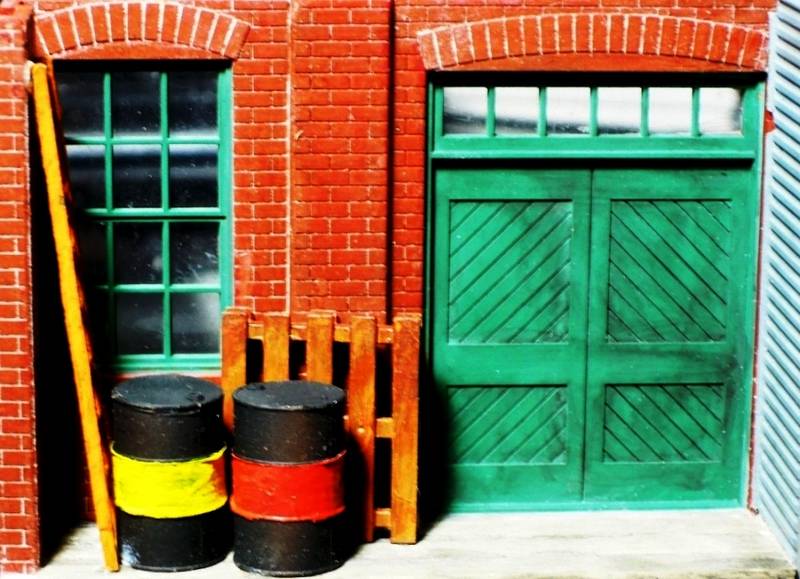Hello Claude –
“that build would be a great challenge” – said the man who knows just what that is ;-)
If I ever attempt it, it would be a 2D background behind the bridge and maybe half of the mill building (roofline). In any case, I’d wait for someone to do the Bofors in 1:6, so I could use the 1:48 bridge. I’ve calculated roughly a 1:8 ratio, using the figures on the bridge. If I had to use a 1:35 Bofors, I was thinking I would build a diminishing-scale bridge (like the 2nd train!) using the photo as a template. Maybe everything but the foreground hill in shallow relief; encased in a box.
On the model train expo - I’d appreciate any photos or info of this dio. It must have been a really looong house – or more likely train #1 went into a tunnel hidden behind the house and train #2 came from a separate tunnel. I’m thinking he used a reed switch or similar for the timing. I’m curious – did anything else happen, or were there “scheduled performances”? It sounds brilliant, but a lot of work just for the one effect.
I once saw a photo of a model of a modular layout at a model train expo, done with “humanized” action figures running Nn3 (1:160 3’ narrow gauge) trains - representing 1:24 scale in 1:6! I know it’s a huge hobby in the Netherlands, and I think I read that you had some related work there recently.
Regarding Luxembourg, I was there in 1990 on a bicycle tour with my girlfriend (of the time). She hadn’t been to Europe, so I had planned a sampler for her: 7 countries in three weeks, with a half-dozen train connections. We arrived from Amsterdam, and spent a pleasant Sunday enjoying the capitol city and the valley below.
The next day we rode through the “Alps of Luxembourg” (AKA Little Switzerland) to Grundhof, wishing we had time to do some hiking in the beautiful, rocky woods we were passing through. I can’t recall if the Mosel bike path extended that far at the time, but we rode along the river and had a picnic lunch in Echternach – I just found an image of the riverside pavilion we used; we had the terrace up the stairs to ourselves, with good views.

I have ~1K slides from the trip, but never scanned them. We stayed in Trier that night, then on to Koblenz, boat up the Rhine to Bingen, and train to Heidelberg - where I was stationed in 1967 - I have a poster from a studenten club advertising a “Happy Hippie Love-in”. Enough OT.
/=/=/=/=/=/=/=/
Regarding the Bofors 40 image, I came across it while looking for any Bailey Bridge photo I could find during my initial infatuation. There was no identification on the site, or I failed to record it if there was. I tried asking on the Axis History Forum (perhaps where it came from), and looked at every image on the BaileyBrug site, but with no luck. Then one day I happened to notice a tiny photo printed on the side edge of the Wespe kit box, shot from the same angle but at river level, labeled as 10 December 1944, Sarriensming, FR. With that info I was able to find the Wespe image online, as well as modern photos with the river and the restored mill, although there is a large modern bridge now. History and photos here:
http://www.150th.com/rivers/sarre.htmI think I found more text somewhere else, as I seem to recall mention of a spotter in the town for the German artillery. I just found a 6-page Word doc (12/5-12/15 1944) I can send in response to a PM - might need a direct email adress. One photo shows the “short, sharply curving bridge approach” mentioned in the text at the top of the page. It’s a bit confusing, as some images in the middle of the page show Sarreguemines, which is clearly a much larger, more urban town - 2.5 klicks downstream. But then at the bottom it discusses Sarreguemines, while the pictures are clearly of Sarriensming. Some images of Sarreguemines look similar to the Besancon bridge - another interesting but even more difficult diorama candidate, even if you don't include the buildings.

Also near the bottom of the page is a short history of the three bridges at this location, and two photos of an improved Bailey with walkway from after the war. You can see part of a mid-river pier from the earlier bridges on the left edge of the Bofors image. What I don’t know is whether the wooden bridge was taken out by another flood or the Germans; in any case, I think it had to be shortly before the Bailey photos were taken. It looks like very high water, judging by the level at the wheel of the mill. I had been thinking this was the only asymmetrical Bailey that I had ever seen, but photos indicate the downstream side was also doubled after the Bofors photo was taken. Actually, the second photo on the site (click to enlarge), appears to show engineers having a discussion. I had initially taken the three figures on the bridge in the Bofors photo as villagers, but now think they’re the same engineers seen on the 150th site.
The mill as it looks today:

The roller dam and church tower are out of view in the WW2 Bofors photo, but the mill façade is a definite match.
I suspect it was just a casual photo, but with lucky composition. I like the perspectival separation between the foreground and the background. I also like the idea of a wooden bridge supporting a metal one – I think that’s the only such Bailey install I’ve seen.
Äddi, Charles


































